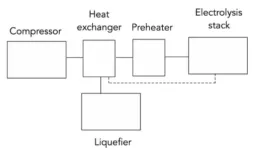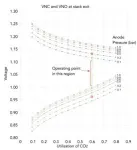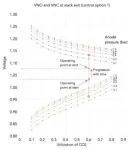(Press-News.org)
Human missions to Mars will require a substantial launch vehicle to ascend from Mars to rendezvous with a waiting Earth return vehicle in Mars orbit. For an ascending crew of 6, the current best estimate of oxygen propellants required for ascent is about 30 metric tons. Producing oxygen for ascent propellants and possibly life support from the indigenous CO2 on Mars, rather than bringing oxygen to Mars from Earth, is of significant benefit. The oxygen production is accomplished through a process known generically as in situ resource utilization (ISRU). Since the Mars Oxygen ISRU Experiment (MOXIE) Project demonstrated operation of a prototype electrolysis system for converting Martian CO2 to O2 on Mars with great success, it is now appropriate to investigate scaling up this prototype to a full-scale system. In a research paper recently published in Space: Science & Technology, Donald Rapp and Eric Hinterman modeled the performance of a full-scale Mars in situ resource utilization (ISRU) system to produce 30 metric tons of liquid O2, operated for 14 months as the Mars environment changes diurnally and seasonally.
First, the authors introduce the ISRU system layout, requirements, and settings. The simplified layout of the ISRU system is shown in Fig. 1. The heart of the system is the stack (or, more likely, a set of stacks) of electrolysis cells, producing a flow of O2 out of the anode and a mixture of CO, CO2, and inert gases in the cathode exhaust. While the process operates, a compressor first pulls Mars atmosphere into the system and compresses it from Mars pressure to stack pressure. A heat exchanger recuperates some heat from the exhaust gases to incoming gas from Mars, and this gas is preheated to stack temperature before entering the stack. After the electrolysis in the stack, the effluent from the stack is fed back to the heat exchanger to prewarm incoming Mars gas, and the cathode exhaust is vented, while the anode exhaust is fed to the liquefier. Moreover, it is critical that the voltage across the electrolytic cells of the stack(s) must be greater than the Nernst voltage for the oxygen production reaction (0.96 V) and less than the Nernst voltage for side reaction that deposits carbon (1.13 V). The system is required to be on a 14-month (420-sol) run with an average oxygen production rate of 3.0 kg/h to produce a total of 30240 kg of oxygen over this period. There are also several control schemes (see Table 1). In option 1, the electrolysis stacks and the liquefier are operated at constant flow rate 3.0 kg/h, while the compressor revolutions per minute (RPM) is controlled to be greater when the Mars density is lower, and vice versa. In control option 2a, the RPM is always maintained at 3325, and the compressor is the same size as in control option 1, but the number of cells in the stacks is reduced. In control option 2b, the RPM is always maintained at 3325, and the number of cells is the same as in control option 1, but the size of the compressor is reduced. In control option 2c, the number of cells and compressor size are the same size as in control option 1, but the RPM is always maintained at 2705.
Then, the authors examine the intrinsic area-specific cell resistance (iASR), current density (J), and flow rate in different control options. The basic relationship: Vop = <VNO> + Vother + (iASR)(J) is used, in which Vop is the average operating voltage applied to a cell; <VNO> is the Nernst potential for O2 production, averaged across a cell; Vother is a voltage added to balance the equation. In addition, anode pressure = cathode pressure = 0.2 bar, utilization = 0.60, and iASR is assumed to start at 1.00 ohm-cm2 and increase to 1.20 ohm-cm2 after 420 sols of operation. In control option 1, the required cell area to produce 3 kg/h of oxygen is AT = 83750 cm2. With cells of area 100 cm2 each, this requires 840 cells. The span of cell-operating voltages is Max Vop = 1.060, Avg. Vop = 1.048, and Min Vop = 1.036. The RPM varies from 3325 at minimum density, to 2706 at average density, to 2251 at maximum density. In control option 2a, Max Vop = 1.114, Avg. Vop = 1.078, and Min Vop = 1.037. The maximum average cell voltage is perilously close to the Nernst voltage for carbon formation, and considering the uncertainties in estimating iASR, this option is unacceptable. In control option 2b, Max Vop = 1.077, Avg. Vop = 1.048, and Min Vop = 1.014. In control option 2c, Max Vop = 1.077, Avg. Vop = 1.048, and Min Vop = 1.014, which are essentially the same as for control option 2b. The results for the various options are shown in Table 3.
In the above table, change number of cells to 840, 670, 840, 840
Finally, authors discuss the results and draw conclusions. As for the solid oxide electrolysis (SOXE) system, the electrochemical power is 14.6 kW for control option 1 and 4.87*FO2 kW for control option 2. The preheat power is estimated to be ~0.5 kW. The heat loss is approximately 0.35 kW, although it depends on atmospheric conditions. The total SOXE power for any control option is the sum of the electrochemical power, preheating power, and heat loss power. The runs for the various control options yield the results shown in Table 4. As for the compressor, the adiabatic efficiency is a function of inefficiencies of its components, including motor losses, seal friction, and bearing friction. Table 5 summarizes power requirements for compression in various control options. The rate of heat removal from the system by the cryocooler is calculated as the cooling required to lower the temperature of the gaseous oxygen to its boiling point and liquefy it. The result is shown in Table 6. Total power including all contributions is concluded in Table 7.
END
SPOKANE, Wash. – New animal research suggests that little-studied brain cells known as astrocytes are major players in controlling sleep need and may someday help humans go without sleep for longer without negative consequences such as mental fatigue and impaired physical health.
Published in the Journal of Neuroscience, the study found that activating these cells kept mice awake for hours when they would normally be resting, without making them any sleepier.
“Extended wakefulness normally increases sleep time and intensity, but what we saw in this study was that despite hours of added wakefulness these mice did not differ from well-rested ...
WASHINGTON—The Endocrine Society today announced it has chosen 14 leading endocrinologists as winners of its prestigious 2024 Laureate Awards, the top honors in the field.
Endocrinologists are scientists and medical doctors who specialize in unravelling the mysteries of hormone disorders to care for patients and cure diseases. These professionals have achieved breakthroughs in scientific discoveries and clinical care benefiting people with hundreds of conditions, including diabetes, thyroid disorders, obesity, hormone-related cancers, growth problems, osteoporosis and infertility.
Established in 1944, the Society’s Laureate ...
Earth’s rapidly changing climate is taking an increasingly heavy toll on landscapes around the world in the form of floods, rising sea levels, extreme weather, drought and wildfire.
Also at growing risk are the values of property where these hazards are projected to worsen, according to a new study by University of Utah scholars. The research team, led by biology professor William Anderegg, attempted, for the first time, to quantify the value of U.S. property at risk in forested areas exposed ...
ALBUQUERQUE, N.M. — Sandia National Laboratories has produced its first lot of a new world-class ion trap, a central component for certain quantum computers. The new device, dubbed the Enchilada Trap, enables scientists to build more powerful machines to advance the experimental but potentially revolutionary field of quantum computing.
In addition to traps operated at Sandia, several traps will be used at Duke University for performing quantum algorithms. Duke and Sandia are research partners through the Quantum Systems Accelerator, one of five U.S. National Quantum Information Science Research Centers funded by the Department of Energy’s ...
Bias in the collection of data on which Artificial Intelligence (AI) computer programmes depend can limit the usefulness of this rapidly growing tool for climate scientists predicting future scenarios and guiding global action, according to a new paper by researchers at the University of Cambridge published in Nature’s npj |Climate Action series.
AI computer programmes used for climate science are trained to trawl through complex datasets looking for patterns and insightful information. However, missing information from certain locations on the planet, time periods or societal dynamics create “holes” ...
The AI model was more efficient at detecting signatures of atrial septal defect (ASD) in electrocardiograms (ECG) than traditional methods.
Investigators from Brigham and Women’s Hospital, a founding member of the Mass General Brigham healthcare system, and Keio University in Japan have developed a deep learning artificial intelligence model to screen electrocardiogram (ECG) for signs of atrial septal defects (ASD). This condition can cause heart failure and is underreported due to a lack of symptoms before irreversible complications arise. Their results are published in eClinicalMedicine.
"If we can deploy our model on a population-level ECG screening, ...
How do children and adolescents evaluate and reason about acts of physical violence in the context of chronic violence that impacts their communities? Previous studies have used situations that correspond with a single act of interpersonal harm void of broader conditions of violence shaping the context in question. A new study released in Child Development examined how youth exposed to gangs known as maras (e.g., MS 13) in Honduras morally deliberate about conditions of gang violence compared with youth not exposed to gangs in Nicaragua, where there are very few maras ...
According to the World Health Organization, globally, infectious disease is a leading cause of death among children. Furthermore, children are more likely than adults to contract infectious illnesses. However, there’s a gap in research measuring children’s responses to sick faces. It is important to understand how children’s ability to recognize and avoid sickness emerges and develops to help improve children’s health and public health more broadly. Previous research has only reported that adults can use faces to recognize if someone is sick and make judgments about whether to approach or avoid them.
Researchers from the University ...
PHILADELPHIA – Patients with pancreatic cancer who took the benzodiazepine lorazepam (Ativan), commonly prescribed to treat anxiety during cancer treatment, had a shorter progression-free survival than patients who did not, according to results published in Clinical Cancer Research, a journal of the American Association for Cancer Research (AACR).
In contrast, patients who took the benzodiazepine alprazolam (Xanax) had a significantly longer progression-free survival than patients who did not.
Benzodiazepines are a class of drugs that suppress the activity of the central nervous system, which can relieve ...
Reasoning skills are crucial skills in learning, academic performance, and everyday problem-solving. According to a recent study conducted at the University of Eastern Finland, improved overall diet quality and reduced consumption of red meat, as well as increased time spent in reading and organised sports enhanced reasoning skills among children over the first two school years.
“Children with healthier eating habits showed greater cognitive development than other children. Specifically, better overall diet quality, ...





